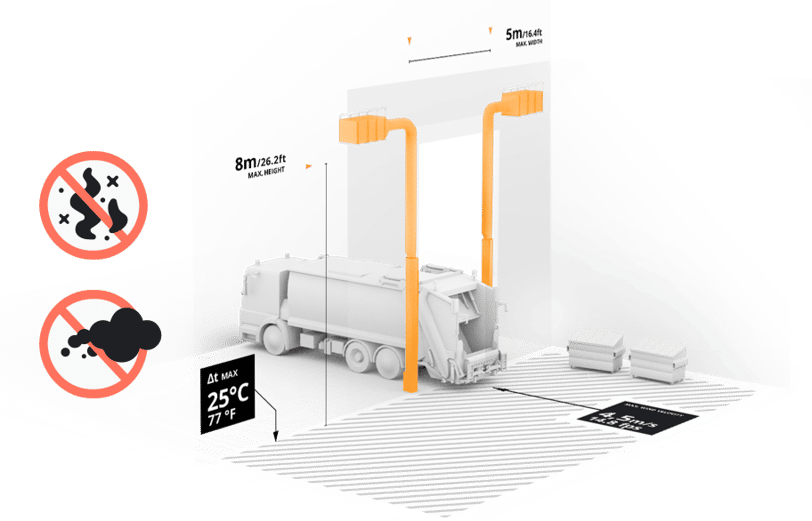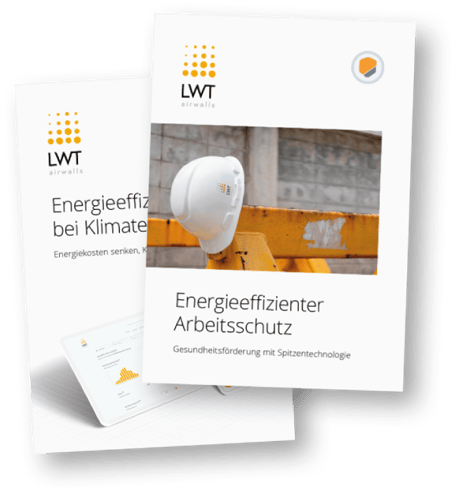
The air stays clean: Odour and smoke control with Airwalls
Odours can become a problem for companies: When a well-known retail chain was looking for a solution to keep the intense smell of the fish counter away from the rest of the store, we developed the first Airwall specifically for this application. Today, this technology benefits numerous companies that want to keep unpleasant odours, dangerous gases or disturbing dust away from production halls or sales areas. Smoke can also be specifically stopped with our airwalls, so that escape routes remain safe in an emergency.
When odours must be prevented
Companies must keep the air clean. Limit values for fine dust or gases are specified to protect employees, visitors, customers and the environment. Depending on the business, however, these pollutants or foul odours are a by-product that cannot be avoided.
Waste disposal companies, for example, cannot prevent the materials to be recycled from being an odour nuisance for employees and, depending on the type of waste, an environmental hazard. The legal requirements for this are complex, as the upstream airlock must have automated rolling doors and elaborate ventilation systems. But there is a better solution.
Simpler, cheaper and more environmentally friendly, on the other hand: LWT airwalls. The effectiveness of our technologies is verified by expert opinions.
Airwalls protect against odour, dust and smoke
Airwalls reliably separate layers of air, so they can meet the requirements of the Federal Immission Control Ordinance (BImSchV). They are more efficient and environmentally friendly than air curtains. Waste management companies can therefore reduce operating costs with LWT airwalls, while at the same time improving the working environment for employees. The air barriers also seal off passages where, for example, trucks are parked that are being unloaded. Airwalls also protect against fine dust, i.e. air particles smaller than ten micrometres, as well as smoke, which can improve the long-term health of employees.
Read our casebooks to find out how versatile our technologies are.

Learn more in our casebooks
- Energy efficiency
- Occupational safety
What our airwalls can do:
- meet the requirements of the Federal Immission Control Ordinance
- seal off entrances without making them impassable for employees
- protect the environment and employees
- reduce energy consumption and thus emissions
We are very satisfied: Our airwalls are working trouble-free! It only smells in the hall, not outside.
Operations manager at the REMONDIS LVP plant, Erftstadt
Do you have any questions?
We will be happy to advise you!
FAQ
Airwalls are systems that accelerate air to high speeds with the help of fans and compress it into a thin jet via a patented nozzle (pressure linear module). The generated air jet prevents layers of air from mixing. Our units can be mounted on the side of gates or above doors. The air jet then separates the air over the entire height. This keeps cold air outside in winter, for example, and does not cool the air indoors. Airwalls are modular and therefore have a lot of planning freedom. They can therefore also be retrofitted without any problems.
Air curtains have a lower air velocity and need a large volume of air to function. As a result, air curtains do not separate different layers of air, but mix them. As a result, if they are used to keep warm air indoors, for example, they need much more energy because they have to heat more air and the heated air mixes directly with the cold outside air. Our systems, on the other hand, work with a small volume of air at high speed and can thus reliably keep air milieus apart. This makes airwalls more energy-efficient and helps companies achieve climate protection goals.
Our Airwall Compact can be installed by customers themselves. For larger installations like our Airwall Grand, we work together with customers to plan the project, manage the installation and control the result. We work together with long-standing partners who take care of the optimal installation with a lot of expertise and enthusiasm. All planning steps are transparent and discussed with customers. Depending on the size and other general conditions, however, the installation can take different lengths of time.
Since airwalls reduce energy consumption in the long term, an investment usually pays off after a short time. The payback depends on the type of use, the size of the doors and the building, as well as energy prices. The mix of energy sources for electricity also plays a decisive role. However, most of our air walls pay for themselves very quickly. They are beneficial for the climate from the very first minute.

